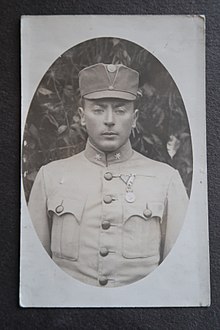Mazepynka

A Mazepynka (Ukrainian: Мазепинка), plural form Mazepynky (Ukrainian: Мазепинки), is a cap worn by Ukrainian soldiers. Created by Levko Lepkyi for the Ukrainian Sich Riflemen in 1916, it was named for 17th-century Ukrainian leader Ivan Mazepa. It has since become a symbol of Ukraine's military,[1] and been adopted by several later groups, including the Ukrainian Galician Army, the Ukrainian Insurgent Army (in a modified form), and, most recently, the Armed Forces of Ukraine since 2015.
History
[edit]The Mazepynka was created by Ukrainian intellectual Levko Lepkyi for the Ukrainian Sich Riflemen, and formally adopted by the unit on 10 January 1916. On 17 January 1917, the government of Austria-Hungary began producing Mazepynky for the unit.[2]
By a formal resolution of the State Secretariat for Military Affairs of the West Ukrainian People's Republic dated 22 April 1919, the Mazepynka was adopted as the hat of the Ukrainian Galician Army,[3] in contrast to the Kyivlanka or Petliurivka of the Ukrainian People's Army. By the summer of 1919, however, the Ukrainian Galician Army was integrated into the Ukrainian People's Army, and the Mazepynka was replaced by the Kyivlanka.[4]
The Mazepynka again garnered the attention of Ukrainian nationalists in 1941, becoming part of the uniform of the collaborationist Ukrainian People's Revolutionary Army and Ukrainian People's Militsiya. A combined form of the Mazepynka and Kyivlanka, known as a "Banderivka" after nationalist leader Stepan Bandera, later became part of the uniform of the Ukrainian Insurgent Army.[5]

A Mazepynka was created by Vasyl Pidhorodetskyi, an imprisoned Ukrainian independence activist, for fellow activist Mykhailo Horyn following the latter's release from Soviet prison in the Mordovian Autonomous Soviet Socialist Republic.[6]
After having used a variation of the Soviet peaked cap since achieving independence in 1991, the Armed Forces of Ukraine adopted the Mazepynka on 4 February 2015.[7] The move was part of a broader rebranding campaign to distance the Armed Forces of Ukraine from the Soviet and Russian militaries, as well as strengthening an independent Ukrainian identity.[8]
References
[edit]- ^ Bohuslavska, Anastasia (17 January 2006). "Український костюм робить жінку привабливішою" [Ukrainian clothes make a woman more attractive]. Ukrainian Youth (in Ukrainian). Retrieved 4 March 2024.
- ^ Chmyr, Mykola; Pinak, Yevhen; Muzychuk, Serhii (2008). Галицька Армія, 1918—1920 [The Galician Army, 1918–1920] (in Ukrainian). Rivne: Oleh Zen. p. 19. ISBN 978-966-2096-19-4.
- ^ Chmyr, Mykola; Pinak, Yevhen; Muzychuk, Serhii (2008). Галицька Армія, 1918—1920 [The Galician Army, 1918–1920] (in Ukrainian). Rivne: Oleh Zen. p. 31. ISBN 978-966-2096-19-4.
- ^ Chmyr, Mykola; Pinak, Yevhen; Muzychuk, Serhii (2008). Галицька Армія, 1918—1920 [The Galician Army, 1918–1920] (in Ukrainian). Rivne: Oleh Zen. pp. 43–44. ISBN 978-966-2096-19-4.
- ^ Muzychuk, Serhii; Marchuk, Ihor (2006). Українська Повстанча Армія [The Ukrainian Insurgent Army] (in Ukrainian). Rivne. pp. 20–21, 25. ISBN 966-7643-71-9.
{{cite book}}: CS1 maint: location missing publisher (link) - ^ "Табірні реліквії родини Горинь" [Camp relics of the Horyn family]. gulag-museum.org.ua (in Ukrainian). Archived from the original on 18 May 2014. Retrieved 4 March 2024.
- ^ "Порошенко облачился в мазепинку" [Poroshenko puts on Mazepynka]. LB.ua (in Russian). 14 March 2015. Retrieved 4 March 2024.
- ^ Pavlov, Vasyl (3 February 2021). "Міф Москви про "братерство" лишився під Савур-Могилою: як за 7 років війни з Росією змінилося обличчя ЗСУ" [Moscow's "brotherhood" myth is under Savur-Mohyla: how the ZSU's clothing changed in seven years of war with Russia]. 5 Kanal (in Ukrainian). Retrieved 4 March 2024.
